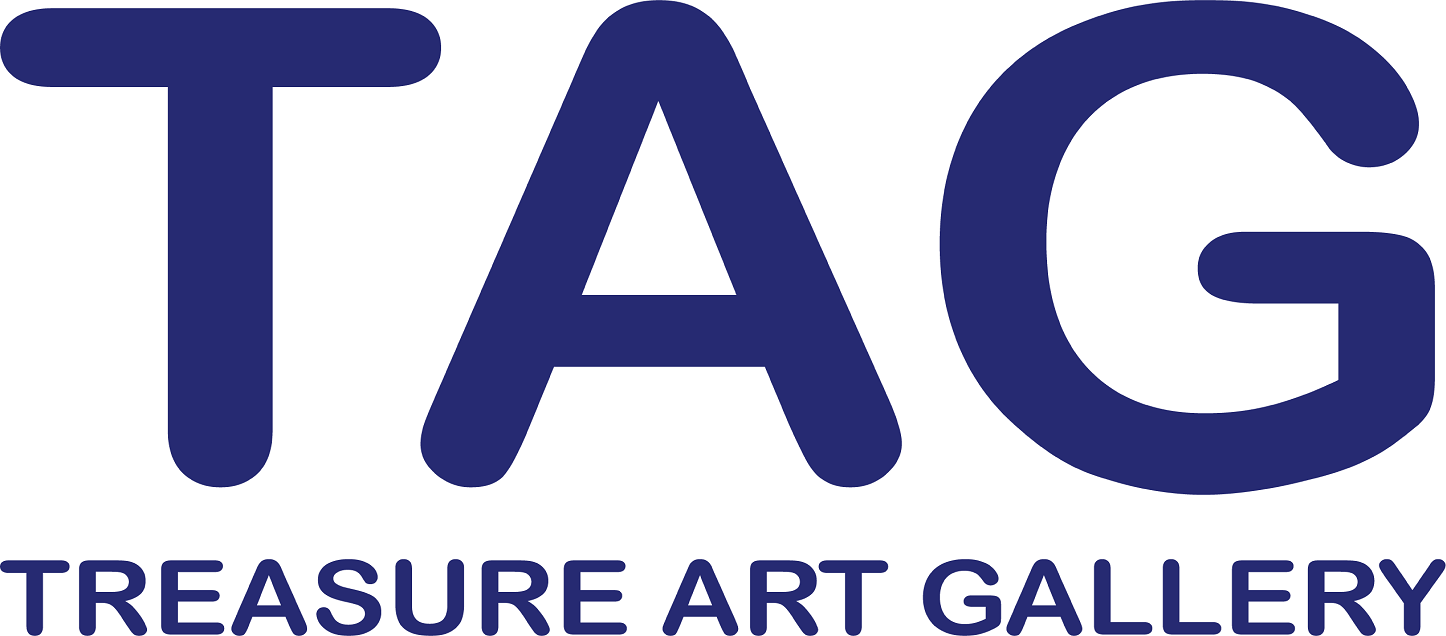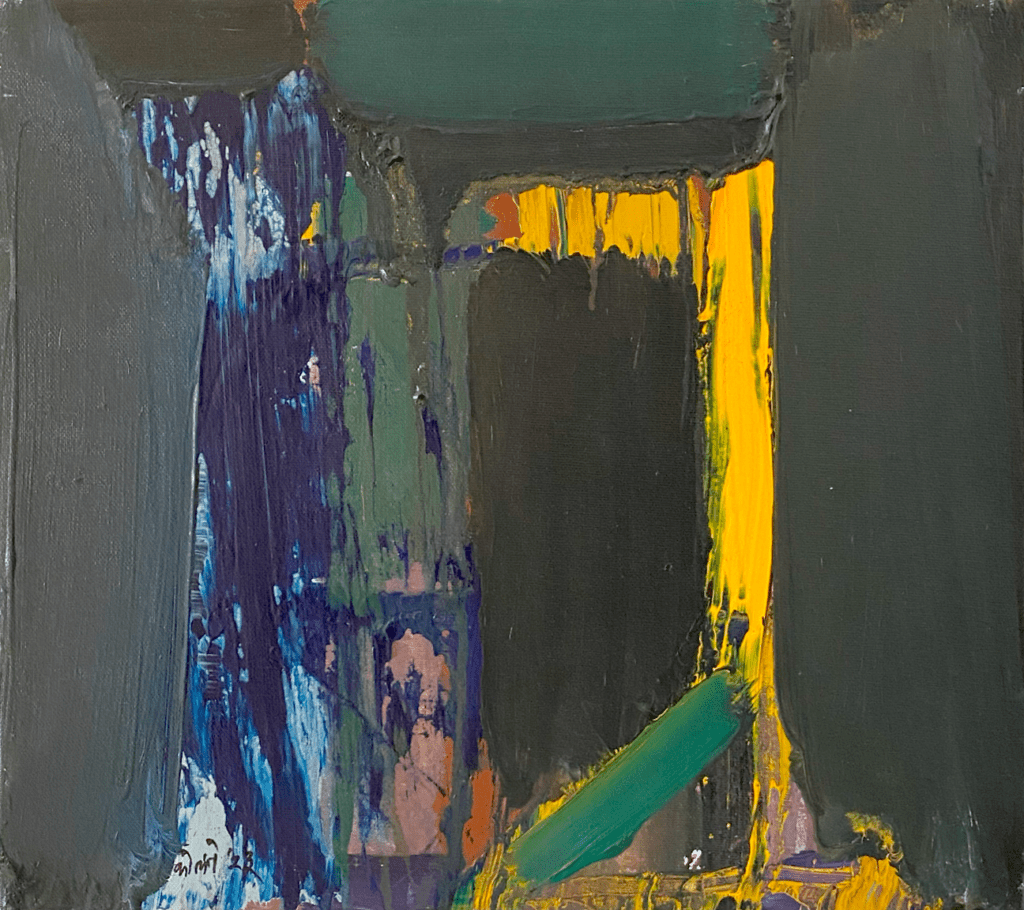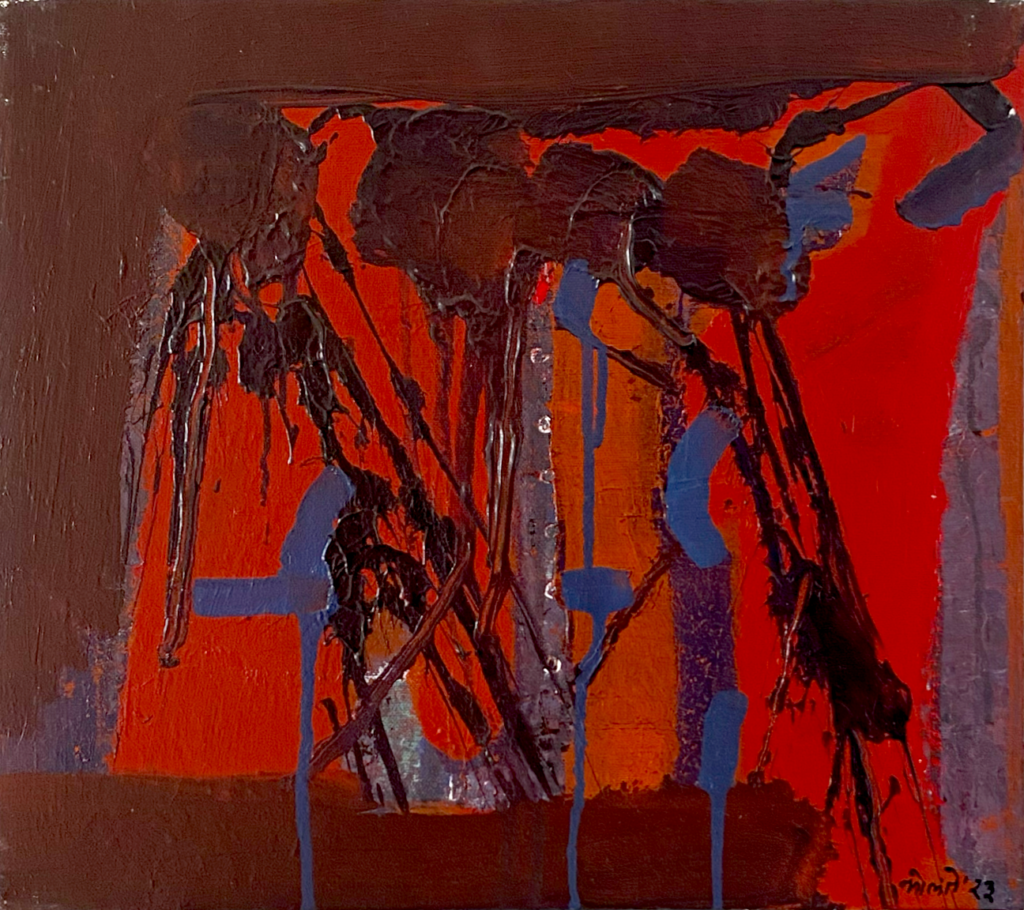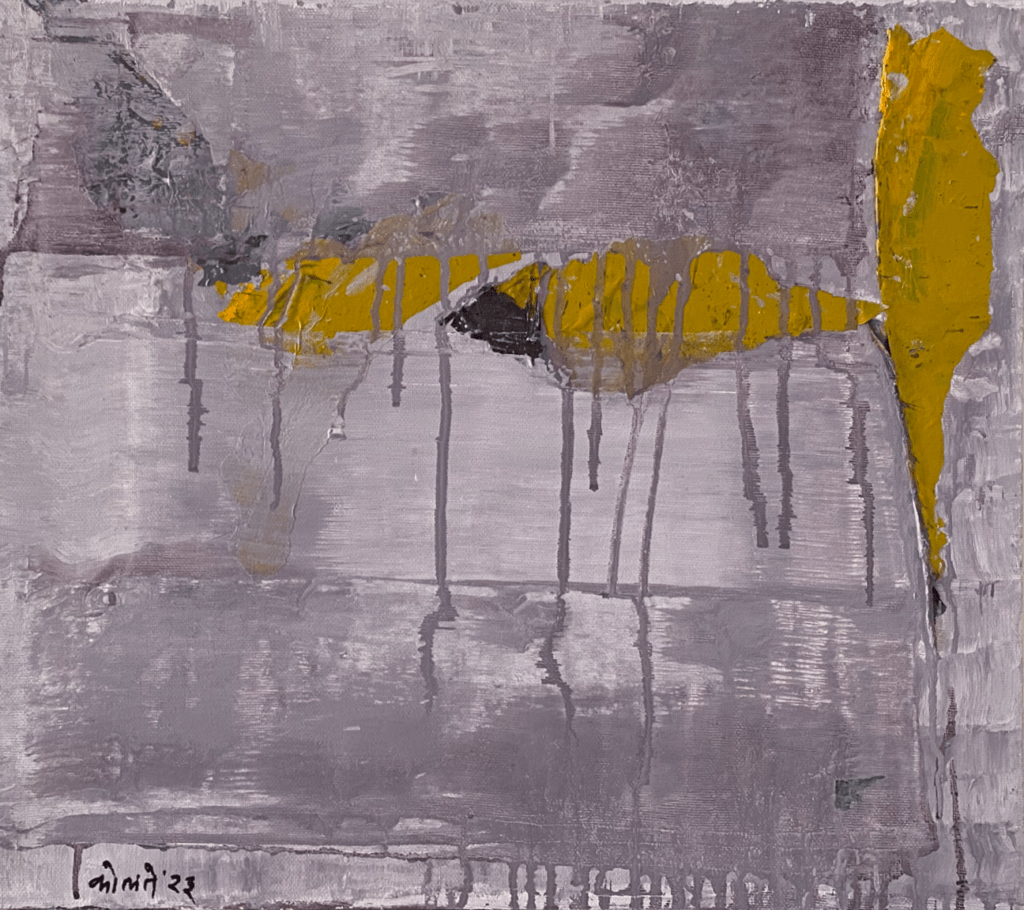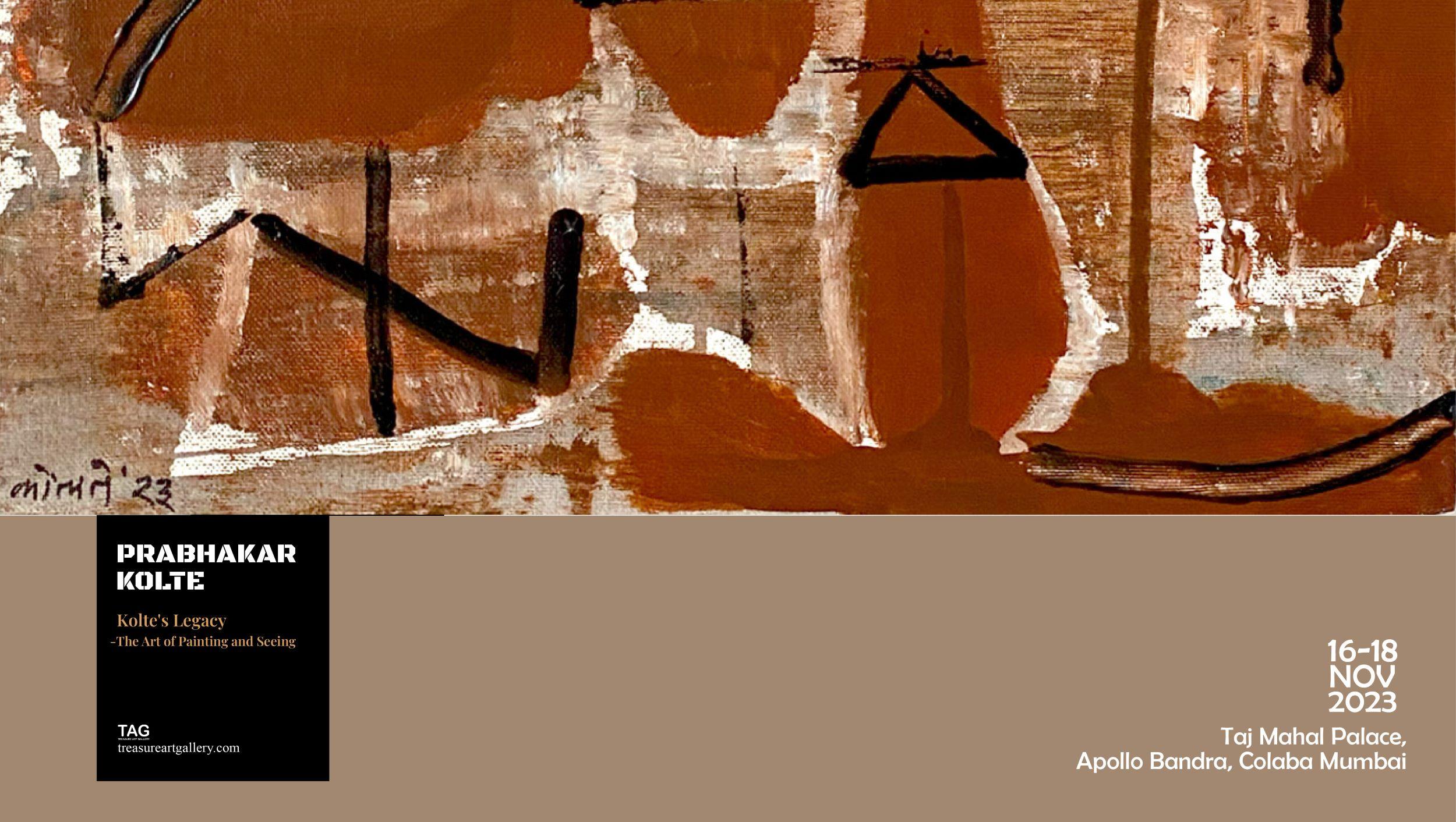
PRABHAKRA KOLTE
Kolte’S Legacy
-The Art of Painting and Seeing
16-18 November,2023
Taj Mahal Palace,
Apollo Bandra, Colaba Mumbai
Prabhakar Kolte was a one of the prominent figure in the realm of Indian Abstract Expressionism, a modern art movement that blossomed in India during the mid-20th century. This artistic movement is characterized by the use of non-representational forms and an empathetic approach to expression.
Kolte, as an artist, dedicated himself to crafting a visual language that transcended the confines of symbolic representation and delved into the profound realms of human experience. His influence places him among the international high modernists who were pivotal in breaking free from the figurative gravitational pull in the world of art.
In an age where expression was more important than means, in a generation that was preoccupied with the human figure, Kolte realised with humility that the figurative world did not meet his needs. He wanted a journey that expressed his world and experiences, a journey that would mirror the surfaces he loved to reflect, surfaces that were expansive and pushed outward in all directions, or surfaces that contracted and cohered inward. Between these two poles he slowly found he had everything he wanted to say.
As an artist Kolte regarded point and line to plane as the “organic continuation” of ideas he had addressed in his earlier works. Drawing elements from his own observations and experimentations on the relationships between form and colour, as well as his extensive readings of perceptual poetry and literature both in Marathi and English, and artistic theory from the twentieth and twenty first centuries Kolte descended into his own practice.
Playing with the geometry of different colour fields in the 80’s and 90’s he explored the relationships between planes; he produced complex and powerful combinations of independent fields and lines during this period, illustrating the manner in which their internal forces and individual characters interacted with one another in different combinations. In this way, Kolte showed the viewer the myriad ways in which a simplified singular vocabulary could be varied and modulated to create ever more interesting and intriguing visual dynamics.
Kolte’s early abstract works displayed a remarkable ability to create a strong sense of tension and dynamism between independent yet interconnected colour fields and slender longitudinal light shafts. He achieved this by combining fluid geometric shapes with delicately variegated colour fields and dense surface effects. In one of his compositions, he skillfully combined sweeping colour fields connected by delicate vertical lines, ultimately forming an almost rectangular shape filled with gradually shifting hues. As the colours intersected and overlapped in increasingly intricate ways, a central form gave rise to a rectangular panel that was further divided into various compartments. Each of these components subtly interacted with the others, producing a dynamic abstract composition that exuded vitality and internal movement, engaging the viewer with its ever-evolving visual tension.
Kolte creates low relief by using the depth of his colour fields. Despite their vibrant colours, the paintings are almost equally flat. These pieces have a certain assurance because to the lean lines and staccato strokes. They are also straightforward facts, but because they were conjured by the mind, they serve as one of the arguments for adding a new dimension to the area provided by a single sheet of paper.
With the minimal minimum of tools, Kolte articulates the forms into a descriptive spatial unity by inserting a nearly continuous febrile line between some colour fields. During this time, Kolte’s sinuous lines between areas, like a streak of light, are unparalleled. Although his admiration for artists like Picasso, Braque, and Paul Klee may have served as an initial inspiration for such abstract linearity, Kolte eventually established a clear, looping style that was all his own.
Kolte’s aesthetic was deeply rooted in classicism, characterized by the exquisite simplicity of shapes, meticulously choreographed composition, and subdued colour palettes. Throughout his life, he drew inspiration from the symbolism of atmospherics and nature. In his own words from 1993, he stated, “Nature first made, then gazed, in my opinion. Because of this, I too have long been driven by the same natural inclination to paint first and see later rather than the reverse.” This profound connection with nature and atmosphere permeated his art, shaping his unique artistic voice.
To contemplate Kolte’s canvases is to be immersed in a realm of unveiled human emotions within the prism of human experience. He skillfully manipulated colour and light, weaving them together to create Zen-like riddles that speak of expansive vistas filled with colour-drenched rectangles. The dynamism of collaboration and context played a pivotal role in his works, often defined by the nature of the shaded edges of his coloured frames and the distinctive “personality” they imparted to the overall composition.
In a 2006 interview, Kolte remarked, “In a way, my works are incredibly perfect, yet there is a shadow, a play, in that exactitude…The boundaries of my colour fields are being weighed in order to add a more minor play element…For me, colour is a creative space with limitless potential. I paint in an abstract style out of choice, experience, and emotion.” Through his many works over the years, Kolte ensured that his paintings were not mere banal studies of formal rules; they were intense, personal reflections on the boundless possibilities of artistic creation. His art invites viewers to explore the depths of his individual sensibility over five decades and to consider the spatial dynamics, sensitivity in observation, and incisiveness in the choice of materials and mediums, be it canvases, paper, acrylics, oils, or watercolours.
The significance of Kolte’s works in the aesthetic discourse of Modern Indian Art, alongside the figurative expressions of his contemporaries, must be viewed within a broader historical context. His art paved the way for several contemporary Indian artists to break free from dominant figurative language and embrace high modernist abstraction. Achieving national recognition across various schools and artistic movements is no small feat for non-figurative artists. In recent times, Kolte’s isolated artistic journey has received well-deserved recognition within the realms of galleries, museums, and auction circuits, further solidifying his place in the annals of art history.
Later, he spent 20 years as a professor at Mumbai’s Sir J.J. School of Art. He achieved a Gold medal from the Bombay Art Society Had an exhibition at the Indo-German Cultural Society in Mumbai and received the “Walter Langhammer Award” from that organization in 1978. Kolte also received an Indian government research scholarship from 1982 to 1984, as well as a British Council visitor ship to England in 1986. In 2010, the Bombay Art Society honoured him with the “Kavi Kusuma Raj Award” and the “Rupdhar – Award” for his contributions to the painting medium. Awarded “Doctorate” for his contribution in the field of art, by Gwalior University, in 2015. New Delhi will host the “Loknayak Jayprakash International Award” in 2020.
Artist Statment
For me painting is a discovery and it helps me to communicate with myself and the world around me, it helps me to learn how to express myself with the visual but complex world around and within. I feel the internal world which we do not see but feel some intrigue and it takes me to the complex situation of expression of art within and without. Today in the contemporary situation of art and expression, I try to apply any views in term of fundamental situation of expression of art and ideas supported by Indian way of expression of Art in a most simplified way. Today art world is full of expression and dynamic ways of exploring the ideas with artistic way and simplified manner of expression, I do not follow contemporary art expression but try to cross over to implement my ways of expression and motivation that suits the way of seeing and following the contemporary situation. While expressing myself it does not consider contemporary ways of art-expression but the content of art and ideas that guide me to follow my own way of seeing and interpreting.
Chronological - Prabhakar Kolte
1946 – 2023
Prabhakar Kolte was born in 1946, in a village called Nerurpar of District Ratnagiri in Maharashtra. He spent his childhood at Dadar at Bavan Chawl where he in 1955-1963 Primary Education from Municipal School, Worli and Secondary school Education from Chabildas Lallubhai Boys High School, Dadar, Mumbai. Later he joined the Sir J.J. School of Art, Mumbai in the year 1964-68. In 1970 he won a few prestigious awards such as the Gold Medal of the Bombay Art Society and the Maharashtra State Awards in 1971 and 1972.
“I have been practicing my way of painting and it will continue till my last breath. For me painting is my passion, it’s my breath and life. – Kolte
Later he taught as a professor for two decades at Sir J.J School of Art, Mumbai. Had exhibition at Indo German Culture Society Mumbai were was Awarded by “Walter Lang hammer Award” by Indo-German Cultural Society, Mumbai, 1978 also got Scholarship as Researcher by Govt. of India in 1982-84 along with British Council’s Visitor ship to England in 1986. He was Awarded “Kavi Kusuma raj Award” and “Rupdhar – Award” for contribution in art of painting, by the Bombay Art Society, in 2010.Awarded “Doctorate” for his contribution in the field of art, by Gwalior University, 2015. “Loknayak Jayprakash International Award” in the year 2020 New Delhi.
He has also received ‘Druga Bhagwat Award’ for his Book ‘From Art to Art – a compilation of various articles on art, in 2010.
Have done several Exhibitions Nationally and Internationally.
Have been writing about international and national artists for the Mauj publication (Marathi magazine).
Have also written for Chinha magazine (Marathi)
Given several lectures in all different art Colleges and Institutes.
EXHIBITION : SOLO
1978 Indo-German Cultural Society, Mumbai
1983 Gallery Chemould, Mumbai
1984 Sir J. J. School of Art, Mumbai only Portraits
1987 Gallery Chemould, Mumbai
1990 Gallery Chemould, Mumbai
1991 Sakshi Gallery, Chennai and Bangalore
1992 Art Heritage, New Delhi
1993 Gallery Chemould, Mumbai
1996 Galerie Foundation for Indian Artist, Amsterdam
1997 Vadehra Gallery, New Delhi
1997 Pundole Art Gallery, Mumbai
1998 Art Heritage , New Delhi
1999 Admit One Gallery, New York
2000 Sakshi Gallery, Bangalore
2001-02 Galerie Muller and Plate, Munich, Germany
2002 Pundole Art Gallery, Mumbai
2005 Art Konsult , New Delhi
2005 Galerie 88, Kolkata
2006 Vadehra Art Gallery, New Delhi
2006 Galerie Muller and Plate, Munich, Germany
2007 Pundole Art Gallery, Mumbai
2011 Reflection, Indore
2013 Jammat, Mumbai
2014 Gallery7, Mumbai
2017 Champaran, Champaran
2018 The Harrington Street Art Centre, Jaipur
2018 Nine Fish, Mumbai
2021 Treasure Art Gallery (TAG), Delhi
2023 Treasure Art Gallery (TAG), Delhi
2023 The Nehru Center, London (TAG)
EXHIBITION : GROUP
1972 ’25 Years of Independence’, Lalit Kala Akademi, New Delhi
1973 National Exhibitions of Lalit Kala Aademi, New Delhi
1973-74 ‘Five Colleagues from Sir J.J. School of Art, Jehangir Art Gallery, Mumbai
1974 ‘Astitva’, organized by Organization of Contemporary Artists, Max Muller Bhavan, Mumbai
1975,86 Contemporary Art in Maharashtra, organized by Directorate of Art, Maharashtra at Lalit Kala Akademi, New Delhi
1975 ‘Five Artists’, Taj Art Gallery, Mumbai
1978. Curated by Geeta Kapur, Travelling International Show.
1979 ‘Twenty Artists’, Alliance Francaise, Mumbai
1984 Biennale of Roopankar, Bharat Bhavan, Bhopal
1986 Contemporary Art in Maharashtra, organized by Directorate of Art, Maharashtra at Lalit Kala Akademi, New Delhi
1986 Biennale of Roopankar, Bharat Bhavan, Bhopal
1986 6th Triennale India, Lalit Kala Akademi, New Delhi
1986 National Exhibitions of Lalit Kala Aademi, New Delhi
1988 Centenary Exhibition of Bombay Art Society, Mumbai
1989 ‘Teachers Exhibition’, Sir J.J. School of Art, Mumbai by KOLTE SIR
————
1988 Centenary Exhibition of Bombay Art Society, Mumbai
1989 ‘Teachers Exhibition’, Sir J.J. School of Art, Mumbai by KOLTE SIR
1990 ‘Art Mosaic’, Celebration of Kolkata’s Tercentenary
1990 ‘Gadyaparva’, Gallery Chemould, Mumbai
1990 ‘Artistic Riot’, Sophia Gallery, Mumbai
1990 ‘Six Bombay Artists’, CMC Gallery, New Delhi
1990 22nd International Festival of Paintings, Conges Sur Mer, France
1991 ‘Contemporary Artist from SAARC Countries’, organized by National Gallery of Modern Art (NGMA), New Delhi
1991 ‘The Rimbaud-91’ Exhibition of Contemporary India Art, Homage to French Poet Arther Rimbaud, Alliance Francaise, Chennai
1993 ‘Wounds’, Centre for International Modern Art (CIMA), Kolkata
1993-94 ‘Parallel Perceptions’, Sakshi Gallery, Mumbai and Pune
1994 ‘Trends and Images’, Centre for International Modern Art (CIMA), Kolkata
1994 ‘100 Years of Indian Art’, National Gallery of Modern Art (NGMA), New Delhi
1994 ‘Hinged by Light’, Pundole Art Gallery, Mumbai
1994 ‘Fantasy’, Centre for International Modern Art (CIMA), Kolkata1995 ‘Bombay- A Tribute to City’, organized by RPG Enterprise, Jehangir Art Gallery, Mumbai
1994 ‘Fantasy’, Centre for International Modern Art (CIMA), Kolkata1995 ‘Bombay- A Tribute to City’, organized by RPG Enterprise, Jehangir Art Gallery, Mumbai
1995 Autumn Exhibition’, All India Fine Arts and Crafts Society (AIFACS), organized by Centre for International Modern Art (CIMA), Kolkata
1995 ‘Watercolour- Broader spectrum, II’, Gallery Chemould, Mumbai
1995 ‘Festival of Perth’, Australia
1995 ‘Print Biennale’, Roopankar, Bharat Bhavan, Bhopal
1996 ‘Perspecta’, Galerie 88, Kolkata at Oberoi, New Delhi
1996 ‘Five Artists’, Gallery Espace, New Delhi
1996 ‘Three Artists’, Maya Gallery, Hong Kong
1996 ‘Highlights’, Centre for International Modern Art (CIMA), Kolkata
1996 Christie’s Auction, London
1997 ‘Chamatkar’, organized by Centre for International Modern Art (CIMA), Kolkata, Whitley’s Art gallery, London
2001 ‘Modern Indian Art’, organized by Saffronart and Pundole Art Gallery, New York
2001 ‘Festival of Perth’, Australia
2004 ‘Image and Imagination’, Gallerie 88, Kolkata
2004 ‘Summer 2004’, C.I. Art Palette, New Delhi
2005 ‘As Within So Without’, with Ganesh Haloi, Art Musings, Mumbai
2005 ‘Still Life’, Art Motif, New Delhi
2005 ‘Concepts and Ideas’, Centre for International Modern Art (CIMA), Kolkata
————-
2004 ‘Summer 2004’, C.I. Art Palette, New Delhi
2005 ‘As Within So Without’, with Ganesh Haloi, Art Musings, Mumbai
2005 ‘Still Life’, Art Motif, New Delhi
2005 ‘Concepts and Ideas’, Centre for International Modern Art (CIMA), Kolkata
2005 ‘Bridge’, Art Alive, New Delhi
2005 ‘Indian Contemporary Painting’, Aryan Art Gallery, New Delhi
2005 ‘Towards Abstraction’, Threshold Art Gallery, New Delhi
2005 ‘Still Waters Run Deep’, Hacienda Gallery, Mumbai
2005 ‘Papyri : Works on Paper’, Alekhya, Baroda
2005 ‘Gray: Exhibition of Contemporary Art’, Gandhara Art Gallery, Kolkata
2005 ‘Unarticulated Parallels in Contemporary Indian Art’, Art Pilgrim, New Delhi
2005 ‘Synchrome’, Akar Prakar, Kolkata
2007 Studio Confluence, Mumbai
2007 ‘colours of Art’, Presented by Galerie Sara Arakkal and Gallery Art Resource Trust at Jehangir Art Gallery, Mumbai
2007 ‘Does Size Matter’, Art Konsult, New Delhi
2007 ‘Abstracts, Rupa – Arupa’, organized by Galleria, Mumbai at Museum Gallery, Mumbai and Visual Arts Gallery, India Habitat Centre, New Delhi
2007 ‘Body Mind Soul’, organized by Gallery Threshold at Visual Art Gallery, India Habitat centre, New Delhi
2007 ‘The Workshop’, India Fine Art, Mumbai
2007 17th Anniversary Show, Gallery Sanskriti, Kolkata
2008 ‘Freedom 2008 – Sixty Years of Indian Independence’, Centre for International Modern Art (CIMA), Kolkata
2008-09 ‘Expanding Horizons: Contemporary Indian Art’, Traveling Exhibition presented by Bodhi Art at Ravinder Natya Mandir, P.L.Despande Kala Academy Art Gallery, Mumbai; Sant Dyaneshwar Natya Sankul Art Gallery, Amravati; Platinum Jubilee Hall, Nagpur; Tapadia Natya Mandir Sports Hall, Aurangabad; Hirachand Nemchand Vachanalay’s, Solapur; Acharya Vidyanand Sanskrutik Bhavan, Kolhapur; PGSR Sabhagriha, SNDT, Pune; Sarvajanik Vachanalaya Hall, Nasik
2008 ‘Harvest 2008’, organized by Arushi Arts at The Stainless Gallery, New Delhi
2009 ‘Deep In Black’, Galerie Muller and Plate, Munich
2009 ‘Think Small’, Art Alive Gallery, New Delhi
————
2010 ‘Essential, Eclectic,…Ephemeral’, The Harrington Mansions, Kolkata
2010 ‘Masters of Maharashtra’, collection from Lalit Kala Akademi, New Delhi at Piramal Gallery, National Centre for the Performing Arts (NCPA), Mumbai
2010 ‘Master’s Corner’, organized by Indian Contemporary Art Journal at Jehangir Art Gallery, Mumbai; India International Art Fair, New Delhi
2010 ‘Evolve: 10th Anniversary Show’, Tao Art Gallery, Mumbai’, Nehru Centre, Mumbai
2011 ‘Form and Formlessness’, Art Alive Gallery, Gurgaon
2011 ‘Between Seasons’, Gallery Beyond, Mumbai
2011 ‘Adbhutam: Rasa in Indian Art’, Centre of International Modern Art(CIMA), Kolkata
2012 ‘One Eye Sees, the Other Feels’, The Viewing Room, Mumbai
2013 ‘Nothing is Absolute: A Journey through Abstraction’, The Jehangir Nicholson Gallery at Chhatrapati Shivaji Maharaj Vastu Sangrahalaya (CSMVS), Mumbai
2015-16 Kalaghoda festival
2016 Kalaghoda
Awards
Kolte has won a few prestigious awards such as Gold Medal of Bombay Art Society in 1970, Maharashtra State Awards in 1971 and 1972, Walter Lang hammer Award by Indo-German Cultural Society, Mumbai, 1978, Research Scholarship by Govt. of India in 1982-84, British Council’s Visitor ship to England in 1986, Awarded ‘Durga Bhagwat Award’ for my Book ‘From Art to Art’ – a compilation of my various article on art, in 2010, Awarded ‘Kavi Kusumagraj Award’ for my contribution in art of painting, in 2010, Felicitated with ‘Rupdhar- Award ‘ by the Bombay Art Society, 2010, ABP Maza Award for my contribution in Art, 2013, Awarded doctorate for his contribution in the field of art, by Gwalior University, 2015, Felicitated by Art Society of India – 2015, Felicitated with Doctorate by Gwalior University – 2015, Prafulla Dahanukar Foundation Award – 2017 and Member of Advisory Board. Lalit Kala Akademi, New Delhi
Books Done
Have translated Charls Gorhyam’s ‘Gold of Their Bodies’ into Marathi ‘ सोने त्यांच्या देहाचे ‘ which very soon will be published. This novel reflects the passion and agony of World famous painter Paul Gauguin, a marvelous example of commitment and dedication for those who wish to practice art as a passion in life.
Also translated in Marathi “Story of Painting “written in English by Mr. H.W.Janson and Mrs. Dora Jane Janson.
